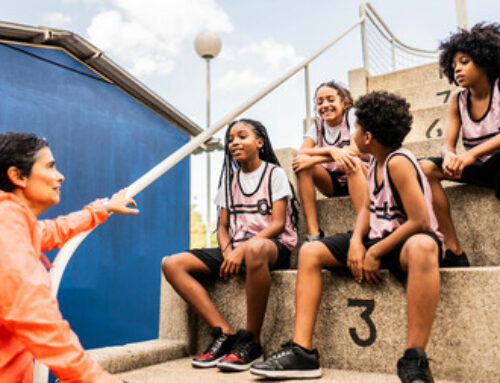Animal Movements and Young Athlete
Animal movement exercises are exactly what they sound like, exercises that mimic animal movements. The most basic one everyone has done since elementary school is the crab walk. There are so much more, though:
- ape
- inchworm
- shrimp
- bear crawl
- alligator wall
These exercises are also more enjoyable to incorporate in any young athlete’s training block as they break up the monotony of sport-specific training. Any coach could incorporate them into any young athlete’s training block once a week or even at the beginning before practice as these movements could also be a great warmup.
However they are incorporated, a coach will find that all these exercises can help the young athlete develop a well-rounded skill set and a greater awareness of their body in space.
Well-Roundedness
The goal of any training block, especially for young athletes, is to become more accustomed to the movements they will need in the game. However, for still-developing young bodies, a well-rounded training block will be more beneficial in the long run.
Animal movements can apply to all sports as they incorporate many complex movements. The ape, crab walk, and frog jump, for example, can be done forward, backward, lateral, and even diagonal from a starting position.
Sports such as football, baseball, and basketball can all benefit from these complicated planes of movement as the demands of the sport require similar movements. For example, an offensive lineman will need to stay low to prevent the defensive tackle from breaking through. The ape movement mimics this same tactic. Wrestling similarly replicates this tactic as the opponents attempt to get the better angle to pin each other to the mat.
Furthermore, animal movements deviate from the norm of sprints, sport-specific training, and resistance training. Young athletes will find these abnormal movements fun and engaging, enhancing the mind-body connection as they work through the best method to accomplish the movements.
Body Awareness
Enhancing the mind-body connection improves a well-rounded young athlete and will enhance awareness of overall body position. Having a greater sense of your body position is half the battle in winning. A young athlete who better understands instinctively where their limbs are has a far superior chance of succeeding than one who does not.
For instance, elite athletes in gymnastics are often lauded for their apparent body awareness. Animal movements can play a vital role in preparing young athletes for enhancing their body awareness.
Possibly the most significant animal movement in teaching body awareness is the inchworm. Starting from a standing position to then touching the ground, walking out with your hands before walking your feet to your hands will improve knowing your body’s position as it goes through multiple planes.
Another great movement to utilize would be the alligator walk. Getting as low as you can to the ground from pushup position then walking out with your right hand and left foot simultaneously followed by the opposing limbs will greatly improve body position knowledge.
The Ape
Benefits: Builds core stabilization, body awareness in all planes, develops rotator cuff strength, stability, and stamina, develops the posterior chain
How-To:
- Begin in a squat position
- Put hands flat in front of you
- While lifting hands and staying low, jump forward
- When hands hit the ground, utilize momentum to propel the body forward
- When feet hit the ground, continue
- Repeat
Can be done forward, backward, lateral, or diagonal
The Bear Crawl
Benefits: Builds core stabilization, body awareness in all planes, develops rotator cuff synergy
How-To:
- Put hands-on ground
- Keep butt in the air
- Walk forward with the right hand going first followed by left leg then left hand and right leg
- Try to keep legs as straight as possible
Can be done forward, backward, lateral, or diagonal
The Inchworm
Benefits: Builds core stabilization, body awareness in all planes
How-To:
- Begin in a standing position
- Bend down to place hands flat on the ground.
- Walk only hands out as far as comfortable
- Walk feet up to hands
- Repeat
It can be done forward, backward, lateral, or diagonal
The Alligator Walk
Benefits: Builds core stabilization, body awareness in all planes, develops anterior deltoid, pectoralis major, triceps, trapezius, and rhomboid strength and stamina
How-To:
- Begin in the standard pushup position
- Lower body as low as possible
- Walk out right hand simultaneously with the left foot, then follow with opposing limbs
- Repeat
It can be done forward, lateral, or diagonal
Wrap-Up
Animal movements challenge young athletes, incorporate a stronger mind-body connection, and encourage young athletes to maintain their training block. Coaches should explain to young athletes the benefits of these movements, especially the carry-over to their sports and remember to keep the movements enjoyable. These movements will drastically improve a young athlete’s general athleticism and lead to greater adherence to the athlete mentality.
Read More
RECOMMENDED FOR YOU
MOST POPULAR
Animal Movements and Young Athlete
Animal movement exercises are exactly what they sound like, exercises that mimic animal movements. The most basic one everyone has done since elementary school is the crab walk. There are so much more, though:
- ape
- inchworm
- shrimp
- bear crawl
- alligator wall
These exercises are also more enjoyable to incorporate in any young athlete’s training block as they break up the monotony of sport-specific training. Any coach could incorporate them into any young athlete’s training block once a week or even at the beginning before practice as these movements could also be a great warmup.
However they are incorporated, a coach will find that all these exercises can help the young athlete develop a well-rounded skill set and a greater awareness of their body in space.
Well-Roundedness
The goal of any training block, especially for young athletes, is to become more accustomed to the movements they will need in the game. However, for still-developing young bodies, a well-rounded training block will be more beneficial in the long run.
Animal movements can apply to all sports as they incorporate many complex movements. The ape, crab walk, and frog jump, for example, can be done forward, backward, lateral, and even diagonal from a starting position.
Sports such as football, baseball, and basketball can all benefit from these complicated planes of movement as the demands of the sport require similar movements. For example, an offensive lineman will need to stay low to prevent the defensive tackle from breaking through. The ape movement mimics this same tactic. Wrestling similarly replicates this tactic as the opponents attempt to get the better angle to pin each other to the mat.
Furthermore, animal movements deviate from the norm of sprints, sport-specific training, and resistance training. Young athletes will find these abnormal movements fun and engaging, enhancing the mind-body connection as they work through the best method to accomplish the movements.
Body Awareness
Enhancing the mind-body connection improves a well-rounded young athlete and will enhance awareness of overall body position. Having a greater sense of your body position is half the battle in winning. A young athlete who better understands instinctively where their limbs are has a far superior chance of succeeding than one who does not.
For instance, elite athletes in gymnastics are often lauded for their apparent body awareness. Animal movements can play a vital role in preparing young athletes for enhancing their body awareness.
Possibly the most significant animal movement in teaching body awareness is the inchworm. Starting from a standing position to then touching the ground, walking out with your hands before walking your feet to your hands will improve knowing your body’s position as it goes through multiple planes.
Another great movement to utilize would be the alligator walk. Getting as low as you can to the ground from pushup position then walking out with your right hand and left foot simultaneously followed by the opposing limbs will greatly improve body position knowledge.
The Ape
Benefits: Builds core stabilization, body awareness in all planes, develops rotator cuff strength, stability, and stamina, develops the posterior chain
How-To:
- Begin in a squat position
- Put hands flat in front of you
- While lifting hands and staying low, jump forward
- When hands hit the ground, utilize momentum to propel the body forward
- When feet hit the ground, continue
- Repeat
Can be done forward, backward, lateral, or diagonal
The Bear Crawl
Benefits: Builds core stabilization, body awareness in all planes, develops rotator cuff synergy
How-To:
- Put hands-on ground
- Keep butt in the air
- Walk forward with the right hand going first followed by left leg then left hand and right leg
- Try to keep legs as straight as possible
Can be done forward, backward, lateral, or diagonal
The Inchworm
Benefits: Builds core stabilization, body awareness in all planes
How-To:
- Begin in a standing position
- Bend down to place hands flat on the ground.
- Walk only hands out as far as comfortable
- Walk feet up to hands
- Repeat
It can be done forward, backward, lateral, or diagonal
The Alligator Walk
Benefits: Builds core stabilization, body awareness in all planes, develops anterior deltoid, pectoralis major, triceps, trapezius, and rhomboid strength and stamina
How-To:
- Begin in the standard pushup position
- Lower body as low as possible
- Walk out right hand simultaneously with the left foot, then follow with opposing limbs
- Repeat
It can be done forward, lateral, or diagonal
Wrap-Up
Animal movements challenge young athletes, incorporate a stronger mind-body connection, and encourage young athletes to maintain their training block. Coaches should explain to young athletes the benefits of these movements, especially the carry-over to their sports and remember to keep the movements enjoyable. These movements will drastically improve a young athlete’s general athleticism and lead to greater adherence to the athlete mentality.
Read More












